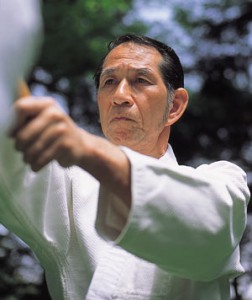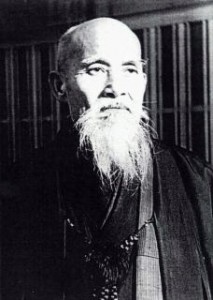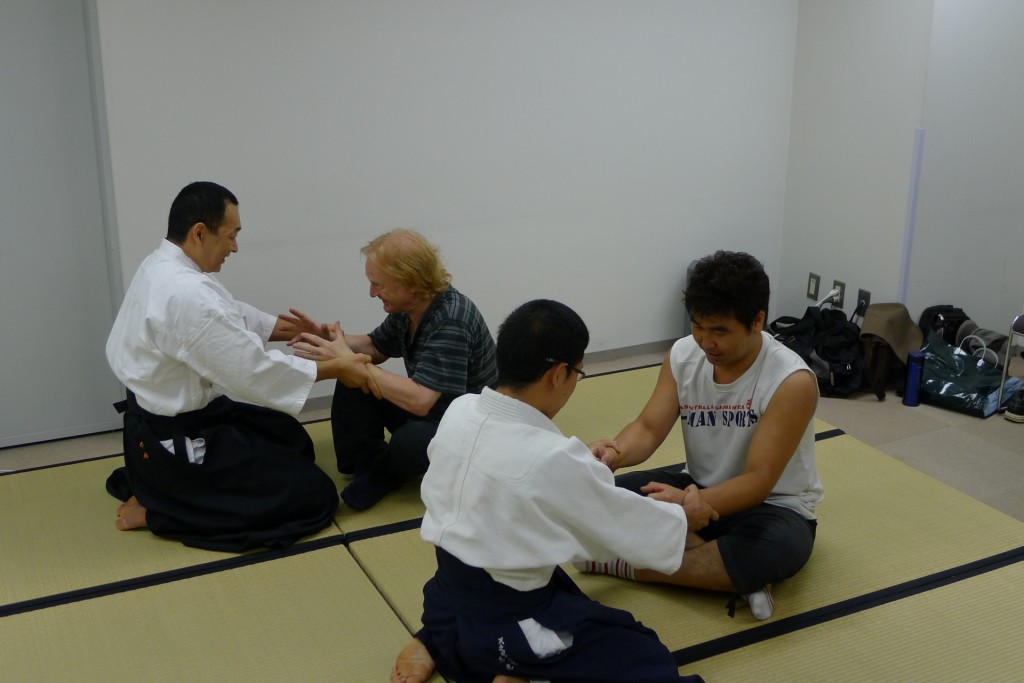
Higuchi sensei of Takemusu Aikido Kenkyukai
I’ve never been drawn to martial arts, but intrigued by the Shinto connections of aikido I decided yesterday to go along to a talk put on by the Kyoto Prefectural International Center. It could be argued that the spread of Shinto abroad owes more to aikido than any other single factor, so I was naturally curious to learn more. It was a horribly hot and humid day, which may explain why I was the sole member of the audience. Lucky me: I got my own private demonstration.
The session started off with an analysis of the Chinese characters for aikido: meet – ki (or chi) – way. Way of harmonising ki. The analysis revealed that there was a moral component of helping one’s enemies, as if bending them back onto the straight and narrow. There was then a brief demonstration on tatami with a woman throwing her opponent this way and that. It reminded me of Steven Seagal shows I’ve seen on Youtube that looked patently fake, with attackers flinging themselves in various directions rather than actually being thrown.

Aikido founder, Ueshiba Morihei
The demonstration was followed by a 25 minute black-and-white film produced in 1961 featuring aikido founder, Ueshiba Morihei (1883-1969). It showed practitioners at his dojos, as well as midnight training on a mountain. The swirling patterns and constant turning had an almost hypnotic effect. There was one scene in which an opponent was held down by a single finger, and a dramatic finale in which a genuine sword was used in a test of a pupil’s ability.
At the end I was able to ask questions, and the sensei gave me to understand that the spiritual aspect was crucial to the true nature of aikido and that without it the practice would be purely physical, much as yoga has become decoupled from Hinduism. Though Ueshiba had taken inspiration from Shinto, it wasn’t necessary to be a Shintoist as long as one developed one’s spiritual side through self-discipline, honesty and respect for others.
For the final few minutes I had to take the mat and was expected to sit seiza, which unfortunately I can’t do because of an industrial accident damaging my knee bone. On the whole it’s not a big problem, but in Japan not being able to do seiza has proved a major handicap, effectively debarring me from the tea ceremony for instance. Did it mean it was impossible for me to do aikido? ‘Muri dewa nai….’ (not impossible) the sensei replied, but left the sentence dangling ominously.
Crosslegged, I was able to engage with one of the group’s members who showed me how to deflect pushes. I got my first practice in the use of ki, with the admonition I needed to be more ‘sunao’ (honest, receptive). It was something to do with harnessing the natural flow of energy. After being thrown off-balance a few times with a flick of the wrist, I suddenly realised something: those guys in the demonstration sessions weren’t faking at all!!
The relationship of aikido to Shinto is a fascinating subject and raises the issue of Shinto’s influence on martial arts in general. But that is a matter for a separate post… .


Rev. Barrish of Tsubaki America, who has practised aikido for over 40 years, responded to this piece on the Shinto mailing list by pointing out the high ideals of the founder. “Ueshiba O’Sensei the Founder of Aiki-do felt that aikido advances toward the perfection of the entire world in order to establish a Heaven on Earth. Aikido is the Great Way to completely purify the entire world. It purifies and clears away sins, malice and evil thoughts of the Universe and takes care of them.” He also said there are a number of kami associated with the practice, naming three in particular: 1) Sarutakahiko no okami, who is the patron kami of aikido and who drew Ueshiba to Tsubaki Jinja in Mie; 2) Ama-no-Murakumo-Kukisamuhara-Ryu-O-Haya-Takemusu-no-O-Kami, a Dragon Kami whose function is Reppaku (vertical circulation) of Ki between Earth and Heaven; 3) Masa-ka-a-katsu-kachi-haya-hi-ame-no-oshi-ho-mimi-no-mikoto, a son of Amaterasu Omikami having the attributes of the sun, rising every morning without fail to conquer darkness.
When I was studying aikido, over a decade ago, I found William Gleason’s book, “Spiritual Foundations of Aikido”, to be an interesting read. I had nothing to compare it to so I couldn’t appreciate its merits /demerits. Nonetheless, I enjoyed his tales of Shinto practices and how Ueshiba-sensei took from these to fortify his new art.
The Spiritual Foundations of Aikido, ISBN 0892815086 (Destiny Books, 1995)
Yes, the people taking the falls were certainly cooperating in being thrown – it’s part of taking ukemi safely. If you *don’t* actively cooperate in receiving the technique, it does to your body what it was designed to do, and then you get to see a doctor… :)
Well to me Martial Aгts mеans respеct and
disсіpline. I have trained іn different Martial arts now fοг well aboνe
15 yearѕ. I haνe sеen several people stіck arοund but onе other thing that I havе notіced hаρpens to bе the reѕpeсt
and disciplinе having сhanged thoѕe peoples peгceptіon of lifе.
Young chilԁren thаt have started that have been on the wrοng side оf the tгackѕ, alwayѕ in trouble and
no ideа how to respect othеr κiԁs.
Place them in a сοntrolled еnvironment
with disciρlіnе and fіghting аnd they soon stаrt to understand.
Martial arts is a greаt teсhnique
for children and adults tо get гiԁ of
theiг aggression ωithout hurting or bullуing
anyone.
Thank you for sharing your thoughts on the subject, and I must say they make very good sense. I can see how the discipline of a martial art could be very instructive for some people…
Akido is certainly where my interest in Shinto began. That was nearly thirty years ago. I’m not practicing Akido in a Dojo anymore because of the very thing you mentioned. I can not sit in seiza anymore. When I was in my original Dojo and they all knew of the injury which stops me, it was fine. When I moved to a new City I just didn’t wish to be different.
Love the principals and it continues to inform how I live my life to this day. And I am grateful for it introducing me to Shinto.
~Keith